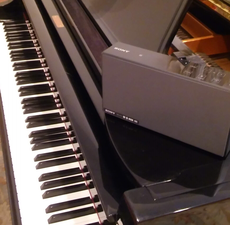
However, once I tried backing tracks with my students, I was kicking myself for not using them sooner! If you have been thinking about using backing tracks in your studio, but aren’t sure how to get started, this post is for you!
In today's post, I will be discussing the benefits to using backing tracks and the equipment you will need to get your studio backing track-ready.
Why use backing tracks?
So what is the big deal with backing tracks? Here are a few reasons I have found backing tracks to be so helpful in my studio:
- They are a great alternative to using the metronome. Most of my students aren’t super-enthusiastic about the metronome, but they love playing with backing tracks.
- They make even simple pieces sound “big.” Backing tracks are perfect for beginning students that want to play sophisticated-sounding music right away.
- They provide valuable ensemble experience. Listening for introductions, playing along with a drum beat, not being distracting by other instrumental parts—these are all valuable skills your students can learn by using backing tracks.
- They are extremely helpful for practicing sight-reading. Much like sight-reading duets, backing tracks encourage students not to stop, no matter what!
- They provide a “carrot” to encourage students to learn a piece proficiently. Use the backing track experience as a reward for learning a piece well and up to tempo.
- Did I mention they are fun?
What set-up is needed for backing tracks?
So, how do you incorporate backing tracks into your studio? The technology isn’t as intimidating as you might think! Many method books now offer backing track technology through dedicated apps (more on that in my next blog post). However, today I will focus on incorporating mp3 backing tracks, such as those found on an accompaniment CD or purchased online as a digital download.
To use mp3 backing tracks in your studio, you will need:
- A device to play back your tracks. If you have a physical CD, of course you can use a stereo to play backing tracks. However, you can also use your laptop, phone, iPad or tablet—whatever works best for you. If you are using a phone, iPad, or tablet to play your tracks, you will want to download your tracks first onto your computer and import them into iTunes (or another music library) so you can access them easily from your other devices.
- An external speaker. If you are using a phone, iPad, or tablet to play your tracks, you'll need an external speaker so your students can hear the tracks over the piano while they play. You can get a simple speaker that plugs into your device via an audio cable, or a Bluetooth speaker that you can connect to wirelessly (mine is shown in the picture above). You can find a decent quality Bluetooth speaker these days for around $25, and they are a great investment. I also use mine to listen to streaming music during the day when I am home and not teaching.
- An app to slow down tracks (optional but very helpful). If you are using your phone, iPad, or tablet to play your tracks, there are several great apps out there that will allow you to slow down an mp3 backing track without affecting the pitch. This is helpful if you want to use your backing tracks as a practice tool and work at different tempos with your students. I use AudioStretch for iPad (the Lite version is free and works with tracks less than 3 minutes long; the full version is $9.99 and can play tracks up to 3 hours long). If you are playing backing tracks from your laptop, you can use Audacity, a free audio editing and recording software program, to slow down your mp3s without affecting the pitch.
Still have questions about the technology? HERE is a great FAQ from the Piano Pronto website, along with a link to a video tutorial about how to import mp3 backing tracks into iTunes.
In my next post,"Backing Track 101: Part Two," we will go shopping for backing tracks and look at the options that are available: from apps, to MIDI, to mp3s. (Spoiler: there are a ton of options!)
What do you think? Do you use backing tracks in your studio? What is your set-up? Any questions about using backing tracks? I'd love to hear from you!

 RSS Feed
RSS Feed